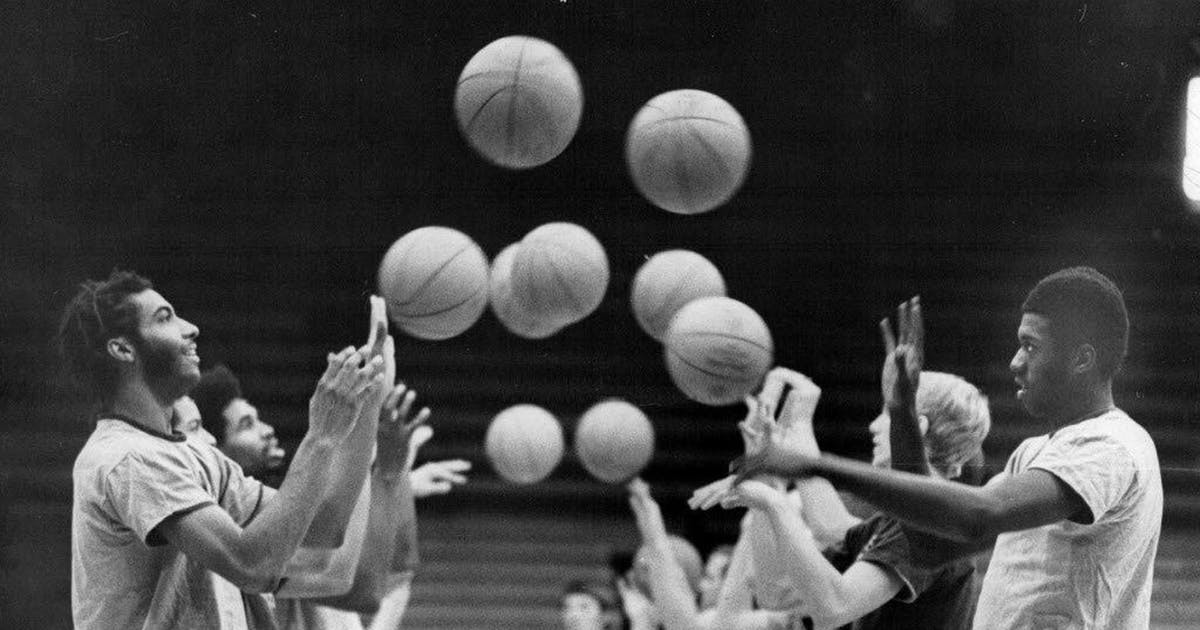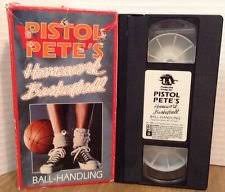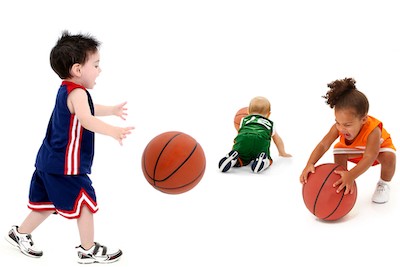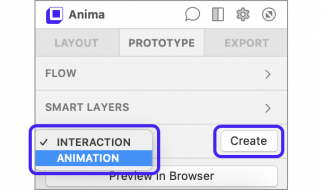A dribbling program with drills that transfer to the game
As a coach, one of the first things players ask is ?how do I improve my weak-hand?? I?ve tested hundreds of dribbling exercises and created a weak-hand dribbling program for all levels, with a natural progression.
When creating the dribbling program, I considered the following criteria:
- player is by themself (1v0)
- player has a ball and a hoop
- there is a natural progression
- no circus drills
 Circus ball-handling Extravaganza
Circus ball-handling Extravaganza
My basketball experience in dribbling
During my younger playing days
I was a 6-foot nothin? shooting guard in high school who would soon be promoted to play the point guard in college. A boy with great discipline and determination, I was ready to accept the challenge. After all, I had spent 30 minutes a day the past summer working on Pistol Pete?s ball-handling and dribbling drills. I could do the spider-dribble better than Spidey himself.
 Pistol Pete?s Homework Basketball VHS tape
Pistol Pete?s Homework Basketball VHS tape
I even spent 15 minutes walking around my neighborhood dribbling a tennis ball (which I saw my childhood hero, Steve Nash, doing in a magazine). Maybe I should have used a golf ball to make things harder?!?!
 Steve Nash not getting better at dribbling a basketball
Steve Nash not getting better at dribbling a basketball
It was a rude awakening in the first college open gym when I brought up the ball and gave it up time and time again. Pistol Pete had failed to prepare me for the real world. Or maybe I had failed myself, after all, I never asked myself: ?do these drills transfer to the game??
I am writing this post because I wish that I had had a mentor that would have told me: these drills do not transfer to games, go find some better ones or go play more 1 on 1.
I highly encourage players to spend less time in isolation and play more 1v1, 3v3, 5v5. However, I realize that we don?t always have the luxury of playing with others, so the next best thing to do is to train 1v0.
4 things that are necessary to improve your dribbling in 1v0
- practice in 3 different speeds (slow, medium, fast)
- if you are not losing the ball then you?re not getting better
- progress out of a drill once it becomes easy
- ask yourself: does this drill transfer to the game? how?
Does this drill transfer to the game? If you don?t answer with a passionate ?YES? then find a better drill
Compliments to Pistol Pete, here are some great examples of drills that have ZERO transfer to the game: https://youtu.be/AmZwbrrBGCk?t=126
Dribbling Program: Improving your weak-hand
I?ve gone through hundreds of dribbling drills in order to find ones that transfer to games, are progressive and can almost be done by a baby.

Start at phase 1 and progress upwards to next phases once the player has proven that they can do the drills fast, without losing the ball.
Phase 1) Stationary dribbling with weak-hand
Purpose: Ideal for beginners and is also a good warm-up. But make sure that you don?t spend too much time in this phase as you start to improve.
- pound dribbles (knee, waist and shoulder height)
- v-dribbles (in front of your body, on the side of your body)
- 4-square dribbling
- 4-crossovers (in-and-out, front cross, b/w the legs cross, behind the back cross)
Phase 1 of Weak-hand Dribbling Program ? Stationary Dribbling
Once you can perform all of these dribbles at max speed with your eyes closed, then you should drastically lower your reps and spend less time in this phase. You will have diminishing returns relative to the time you put in. Next phase, you have to start adding footwork as you dribble with your weak hand.
Phase 2) Dribbling with weak-hand and added footwork
Purpose: These drills will teach the dribbler how to create space with their weak-hand. If a guard can?t relieve defensive pressure by creating space, they are going to get nervous, lose vision, and make bad decisions. If the defense is overplaying their strong hand, they have to make moves with their weak hand.
- pound dribbles into in-and-out jab
- pound dribbles into crossover jab (3 hard dribbles and then jab with your foot opposite side of the ball causing body to jump backwards a bit)
- pound dribbles into ball-side jab (3 hard dribbles then jab with your ball-side foot)
- Scissor dribble (To make this easier you can take 1?2 dribbles before you crossover between legs)
Phase 2 of Weak-hand Dribbling Program ? Adding Footwork
Once you become good at these dribbles then you should close your eyes and perform them. Once you can perform them at max speed, with max intensity and with your eyes closed then you can start varying the rhythm of the dribbles to make things more difficult.
Phase 3) Game-like dribbling & finishing
To be successful in games, you should do the things you?re good at more often than anything else. Drive to your dominant hand every time, until the defense decides to stop it. Once the defense stops it, then you should have a counter and should be able to continue driving with your weak-hand to a finish.
Purpose: Phase 3 drills are moving your body, adding dribbling moves and counters to your dominant hand so you have solutions for when then defense cuts you off.
I taught my 6-year old nephew every imaginable 2-ball dribble drill & he could do them all. Games came around & he still went right every time. I realized if he couldn?t score going left, he wasn?t going to go left. [So we started teaching him how to score going left.] ? Coach Z
Phase 3a) Dribbling off the catch
You can have a teammate pass you the ball or toss the ball out to yourself. You would be positioned on your strong-side wing. So if you?re right-handed then you would start on the right wing. Perform 2 reps of each. Once you get better, then challenge yourself to ?make? 2 of each, instead of just ?take? 2 reps.
- take 2 strong-hand dribbles then spin-dribble and continue to layup
- take 2 strong-hand dribbles then wrap-around-back and continue to layup
- take 1 strong-hand dribble then front-cross and continue to layup
- take 1 strong-hand dribble then between-the-legs and continue to layup
- take 1 strong-hand dribble then behind-the-back (not wrap) and continue to layup
Phase 3b) Dribbling in open court (starting with ball already dribbling)
You can start the ball already dribbling at half-court and dribble towards the Top of the Key (or a different spot)
- Approach 3-pt line with strong hand and perform high-cross move into a weak-side finish
- Approach 3-pt line with strong hand and perform low-cross move into a weak-side finish
- Approach 3-pt line with weak-hand and perform in-and-out move into a weak-side finish
Phase 3 of Weak-hand Dribbling Program ? Game Moves & Finishes
Various open-court moves: in-and-out, high-crossover, wrap around back, drag step, hesitation, cross-jab, push-out cross, push-out stunt
1v1 moves and counters: Inside-out, low crossover, high crossover, protect-the-ball dribble, pull-back dribble, hesitation move, between-the-legs, spin move, behind-the-back, wrap-around-back, combos, double cross, jolt, drag, stutter step
Once you become elite, then you should start from a different spot every day.
Also, note that this was the first time that the player in the video performed these drills. He is dribbling rather slow and you would want to increase the intensity and strength of you dribble as you progress.
The Final Bounce
You become best at dribbling by playing against defenders and having to make decisions of which moves to use and when. This 3-phase dribbling program is an effort to improve your weak-hand when you have no one else to play against (1v0).
Basketball is about patterns and the next progression in 1v0 would be to video tape your 5v5 games and see when defenders are putting you in uncomfortable situations, then use those in your 1v0 training.
I guarantee you that you will notice an improvement within 2 weeks of doing these for 5 minutes each day (elite warm-ups). As always, you have to be going at max intensity and be losing the ball, otherwise you are not getting better. Failure leads to the fastest improvement.
How did I decide which drills to select?
Learn about the Pareto Principle (80/20 Rule) below and ask yourself which 20% of drills give you 80% of the value? This is how I created the 3 phase dribbling workout above.
Pareto Principle (80/20 Rule)
If you liked what you read, follow me on Twitter @kamilski81

